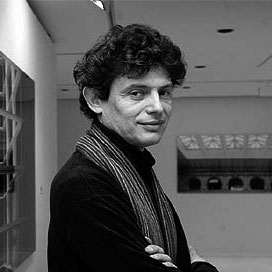Ballester paints and photographs stairs, windows, facades, doors opening out to empty spaces, mysterious corners; he plays with light, a fundamental element in his work, and he seeks an exact beauty that is sometimes disturbing. He is attracted by industrial spaces, hotel rooms, garages, corridors, airports under construction, museums undergoing repairs. His passion for travel has led him to painting and photographing in numerous countries, especially China, the country for which he feels a special fascination.
In that same year we exhibited his photography for the first time, on the occasion of Photespaña. Interiors and exteriors expertly lit, “A photograph in the style of Vermeer because suddenly it does not just provide an incarnation of light, it also converts it into something undulating, progressive, which advances towards the object and keeps us in suspense: a luminous expectation” in the words of Calvo Serraller, author of the text for the catalogue which the gallery published. In 2006 “Construction/demolition” was an exhibition in which photographs which Ballester had produced of the new buildings in China held a dialogue in a kind of confrontation with the images of Zhang Dali who was denouncing the excesses of demolitions going on in the old city of Beijing.
In these last ten years Ballester has b een a constant presence in our stands at Arco, ParisPhoto, PhotoLondon, PhotoMiami, DeFoto, MadridFoto, etc., and he also took part in the collective exhibition of painting s held to mark the change of name of the gallery, in 2010.
His work has been evolving and projecting itself through various languages: parallel with solitary landscapes, bridges, urban architecture, empty interiors, containers, he has developed an interesting series of works on the appropriation of masterpieces from museum s such as the Prado, the Kunsthistorisches Museum in Vienna and others, from which he has taken human figures; thus, Vermeer, Fra Angelico, Botticelli, Bosch, Leonardo de Vinci, El Greco, Velázquez, Goya have been photographed and emptied by him, giving rise to an impressive work which he has called Paisajes Ocultos (Hidden Landscapes). His digital prints, taken at the real size of the original painting, seek to discover the secret elements handled by the artists. The latest example that we have been able to see, titled Paisajes Encontrados (Found Landscapes), is housed in the Lázaro Galdeano Museum, and in a video based on The Garden of Earthly Delights, Ballester explains that in removing the narrative of this famous work landscapes charged with meaning have been found and he affirms: “Virtual reality is today as important as was the discovery of perspective in the Renaissance.”
In the exhibition that we are presenting, the artist has directed his gaze towards hi s most usual and perhaps most loved environment; his studio, but it is not his real studio, rather it is a metaphorical mental space in which it is again light, the line, the disturbing framing, the stamp of memory, which conveys to us the magic or his work. As Lorena Martínez de Corral says in the catalogue to the exhibition La abstracción en la realidad (Abstraction in reality): “Photography is magic and passion, not just reality, and this passion is the activating element for the majority of his works. Ballester expresses it in his work through tension, creativity, beauty and emotion, interpreting a familiar space beyond the limits of reality.”
The exhibition is displaying a large forma t painting and several photographs




























